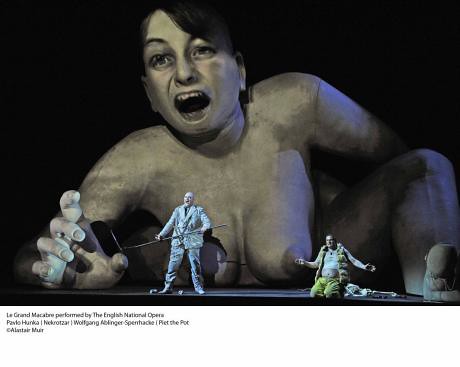

(Le Grand Macabre - ENO, encenação de La Fura Dels Baus)
«But now London has a chance to sample another strand of La Fura's oeuvre, when English National Opera presents its production of György Ligeti's Le Grand Macabre, first seen in Brussels earlier this year. It sold out and won rave reviews: after seeing it, wrote one critic, "even the terminally depressed would be ready to dump the Prozac and pull the chain". Ligeti described Le Grand Macabre as an "anti anti-opera". An exuberant jet-black farce, loosely based on a play by the Belgian surrealist Michel de Ghelderode, it was first performed in 1978, at a time when Boulez and other puritans had made "anti-opera" a fashionable concept. Ligeti, a member of the same avant-garde but a rebel against all orthodoxies and trends, was having none of it: he decided instead to write the most brazenly operatic opera he could, parodying all its conventions and following an extreme story-line, filled with fantasy characters, bawdy jokes and flamboyant gestures.
Yet its underlying theme is deadly serious, quite literally so. It asks, why are we so afraid of death? In Breughel-land, those in charge are obese and corrupt, and about to be popped off by revolutionaries. The charlatan Nekrotzar, "le grand macabre", claims to have returned from the grave to devastate the earth, while the transvestite astrologer Astradamors prophesies that a comet spells further doom. Everyone else is drunk, sex-obsessed or plain moronic. But somehow, the death and destruction that terrifies everybody into their bad behaviour never materialises: the only truth is that life is a lottery, so it's better to be fatalistic and enjoy yourself.
Le Grand Macabre is a classic of late modernism, yet there's been no major production for over a decade.
For La Fura dels Baus, it's a natural fit and audiences at ENO can expect to be shocked and entertained in spades, as Alex Ollé and Valentina Carrosco have focused their staging on a giant revolving fibreglass figure of a naked woman, modelled on their friend Claudia. The action takes place in and out of Claudia's orifices, with costumes linked to bodily organs. Video of the real Claudia is projected on to the surface of the figure, showing her apparently worrying herself to death as she gorges on junk food ("le Grand Mac") and reads petrifying headlines in the newspapers.
Technically, the remotely controlled model of Claudia is a tour de force. "We've done 14 performances and so far nothing's gone wrong," Carrosco says, touching wood. Ollé insists it's not a gimmick, but a rich metaphor for Ligeti's theme, and the sense that fear of death is something that we feel in our bones.
"We don't want empty spectacle," Ollé says. "The work that we've done with the singers is the heart of the production and we've been lucky to find performers who are so receptive to a complete theatrical experience."»
O leitor atento sabe das minhas reservas face aos vanguardistas (?) La Fura dels Baus...
«So begins this extraordinary staging – by Alex Ollé and Valentina Carrasco of the Catalan “total theatre” company La Fura dels Baus – of György Ligeti’s only opera. Claudia is designer Alfons Flores’ creation and she fills the Coliseum stage revolving through 360 degrees to reveal every unflattering aspect of her physiognomy. They say no man is an island, but this woman is. Or to be more precise, she is Breughelland, a paranoid and morally corrupt police state run by a sexually indeterminate Prince sporting a very high voice and lurex tunic (the excellent Andrew Watts). And when a mysterious visitor Nekrotzar (Pavlo Hunka) arrives to announce that the game will be up at precisely midnight, Claudia’s body becomes a repository for the entire world’s fear and loathing.
Allé and Carrasco’s production literally spills from her every orifice. At one point the black and white ministers (or should that be minstrels) of Breughelland (Daniel Norman and Simon Butteriss) emerge, appropriately enough, from her rear end to engage in a slanging match of A-Z obscenities. Claudia’s bowels (groaning under the weight of all that bingeing) are massaged by black-gloved hands before the Chief of Secret Police, Gepopo (the manic coloratura soprano of Susanna Andersson) explodes from within smelling subversion and foul play. Or is that simply smelling foul. Claudia’s worst nightmare, and ours, is an Hieronymous Bosch-like landscape of degradation and delight on which startling video projections (Franc Aleu) cast images of hellfire and decay. Claudia’s fleshly form dissolves into a skeleton before our eyes. Amazing.»
A obra de Ligeti, Le Grand Macabre - não suscitando reserva alguma da minha parte -, mantém-se envolta em polémica, irreverência, ousadia e provocação.
No meio de tudo isto - reservas & polémicas - , é difícil esconder o desejo e curiosidade pela proposta dos catalães...
«This production is all about the set, a gigantic revolving figure of a naked women on all fours, whose orifices and detachable nipples and limbs provide endless scope for exits and entrances. Combined with a dazzling use of video, the visuals are spectacular, but they hardly seem specific to Grand Macabre»
Verdadeiramente, só os burros não mudam.
2 comentários:
Eu vi o Le Grand Macabre quando o levaram a São Carlos (não, não foi nem a Santa Maria nem a São José...) e confesso que gostei bastante. Não é qualquer cantor que é capaz de cantar e actuar numa ópera de tal calibre.
De vez em quando passam pelo TNSC uns laivos de modernidade não necessariamente bacoca e considero que o Le Grand Macabre até foi uma dessas salutares ocasiões. É sem dúvida uma ópera que gostaria de rever. Considero-a bem menos enfadonha, por exemplo, do que o Diálogo das Carmelitas, embora Poulenc e Ligeti sejam dois compositores que eu ame cantar e ouvir.
Gus,
Também lá estive! Na época, não me fascinou... Mas eu acabara de dar os primeiros passos na lírica, so...
Enviar um comentário